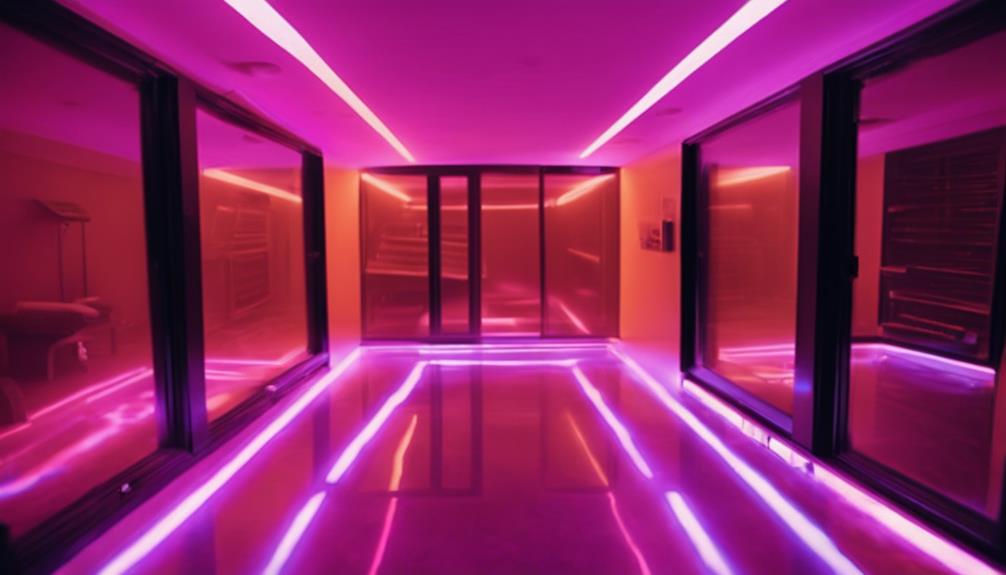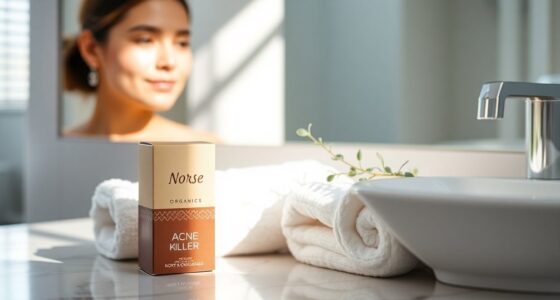Tanning beds might seem like a quick route to flawless skin, but they come with hidden dangers. You're exposing your skin to harmful UV rays, leading to redness, itchiness, and even new freckles or moles. Over time, this can cause premature aging, with increased wrinkles and sagging. Your eyes aren't safe either; they can suffer from irritation and long-term issues like cataracts without proper protection. The idea that you can achieve a safe tan is a myth. If you're concerned about staying healthy while still enjoying the sun, there's much more you need to know.
Key Takeaways
- Tanning beds cause skin damage, leading to redness, itchiness, and peeling, which are signs of skin distress.
- Frequent use accelerates skin aging, resulting in increased wrinkles, sagging skin, and dark spots.
- Excessive UV exposure risks eye health, potentially leading to irritation, cataracts, and macular degeneration.
- Tanning before age 35 raises melanoma risk by 75%, highlighting the severe long-term consequences.
Signs of Skin Damage
Frequent tanning bed use can lead to noticeable signs of skin damage, such as redness, itchiness, and peeling. If you notice lingering redness after a session, it's a clear indication that your skin's in distress and may be damaged.
Itchy rashes often signal irritation from overexposure to UV rays, and persistent itchiness means it's time to cut back on your tanning sessions.
Be vigilant for any new freckles or moles; these can indicate potential overexposure. Monitor any fresh spots for changes in size, shape, or color.
Ignoring these skin warnings can escalate into serious long-term consequences. Protecting your skin now can save you from more severe issues later, so pay attention to what your skin's trying to tell you.
Long-Term Aging Effects
Using tanning beds can speed up the aging process of your skin, leading to wrinkles, sagging, and an uneven complexion. You mightn't notice it immediately, but the long-term effects can be significant.
Here are some common signs of accelerated skin aging from tanning bed use:
- Increased wrinkles and fine lines
- Loss of skin elasticity, leading to sagging
- Development of dark spots and uneven skin tone
- Dullness and lack of radiance in your complexion
Protecting your skin should be a priority. Consider safer alternatives for achieving a sun-kissed glow, and remember that your future self will thank you for it.
Eye Health Risks

While tanning beds may give you a bronzed look, they also pose serious risks to your eye health that you shouldn't ignore.
Excessive UV exposure can lead to gritty or red eyes, indicating potential long-term damage. Without proper protective goggles, your eyes are vulnerable to conditions like photokeratitis, which feels like a sunburn on your cornea and causes significant discomfort.
Additionally, prolonged exposure increases your chances of developing cataracts and macular degeneration later in life. The World Health Organization highlights these risks, especially around the sensitive eye area.
Ignoring the signs of irritation can lead to severe eye-related health issues, so always prioritize your eye protection during tanning sessions to safeguard your vision.
Prevention Strategies
To protect your skin and eyes from the harmful effects of tanning beds, prioritize effective prevention strategies that minimize UV exposure. Here are some key practices to follow:
- Use sunscreen: Always apply a broad-spectrum sunscreen to safeguard your skin, even in tanning beds.
- Wear protective goggles: Invest in properly fitting tanning goggles to shield your eyes from harmful rays.
- Limit tanning sessions: Reduce the frequency and duration of your tanning sessions to lower UV exposure.
- Moisturize regularly: Keep your skin hydrated to help mitigate damage from UV rays.
Health Risks Overview

Tanning beds pose significant health risks that go beyond cosmetic concerns, jeopardizing your skin and overall well-being.
Regular use can lead to accelerated skin aging, increasing wrinkles, sagging, and uneven skin tone. More alarmingly, tanning before the age of 35 raises your risk of melanoma by 75%.
You might notice signs of skin distress like redness, itchiness, or new freckles, which indicate potential overexposure to harmful UV rays. These symptoms shouldn't be ignored, as they can lead to severe long-term consequences, including skin cancer.
Additionally, your eyes are at risk; without proper protection, you could face eye irritation and increased chances of cataracts.
Ultimately, the risks far outweigh any temporary tanning benefits.
Alternative Vitamin D Sources
Many people rely on tanning beds for vitamin D, but there are safer, effective alternatives to meet your nutritional needs without the associated risks.
Here are some great sources of vitamin D:
- Fatty Fish: Salmon, mackerel, and sardines are packed with vitamin D.
- Egg Yolks: A tasty option, egg yolks contain a decent amount of vitamin D.
- Fortified Foods: Look for cereals, dairy products, and plant-based milks fortified with vitamin D.
- Mushrooms: Certain varieties, like shiitake, provide a plant-based source of vitamin D when exposed to UV light.
Myths About Tanning Beds

Despite common beliefs, using tanning beds doesn't guarantee a safe tan or provide adequate vitamin D. Many think that tanning beds are a controlled way to get color without risks, but that's far from true.
You might believe that a base tan protects your skin from sunburn, but it actually doesn't. Tanning beds can increase your skin cancer risk considerably—especially if you start using them before age 35.
Some also think that indoor tanning is a healthy alternative, but the UV rays are still harmful. Plus, the idea that you can achieve a perfect tan without any side effects is misleading.
It's essential to separate fact from fiction and prioritize your skin's health over fleeting aesthetics.
Frequently Asked Questions
How Often Is It Safe to Use Tanning Beds?
It's best to limit tanning bed use to once every two weeks to minimize skin damage. Always monitor your skin for any changes, and consider alternatives like sunless tanning products for a safer glow.
Can Tanning Beds Cause Allergic Reactions on the Skin?
Yes, tanning beds can cause allergic reactions on your skin. You might experience rashes, redness, or itchiness after use. It's important to monitor any unusual skin changes and consult a professional if symptoms persist.
What Are the Symptoms of Tanning Bed Withdrawal?
When you experience tanning bed withdrawal, you might notice symptoms like cravings for UV exposure, anxiety, mood swings, and restlessness. Your skin may feel unusually pale or sensitive as it readjusts to decreased UV light.
Are There Any Tanning Bed Alternatives for a Bronzed Look?
If you're seeking sun-kissed skin, consider safe sprays, shimmering lotions, or bronzing powders. These fabulous alternatives provide a flawless finish without the harmful UV exposure, allowing you to glow confidently without risking your health.
How Can I Effectively Treat Skin After Tanning Bed Use?
To effectively treat your skin after tanning, hydrate with a soothing moisturizer, apply aloe vera for relief, and drink plenty of water. Avoid further UV exposure, and consider gentle exfoliation to maintain skin health.
Conclusion
So, before you step into that tanning bed, think twice. The allure of a golden glow might seem tempting, but the hidden dangers could haunt you for years to come.
Are you prepared to face the risks of skin damage, premature aging, or even more serious health concerns? Protect yourself and consider safer alternatives for achieving that sun-kissed look.
Don't let the desire for a tan blind you to the potential consequences—your skin deserves better.









